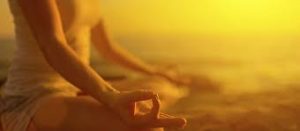The Practice of Pranayama: Breathing Your Way to Good Health
 The past few days we have been discussing the importance of pranayama. Today we finish our discussion with two more techniques to extend your energy.
The past few days we have been discussing the importance of pranayama. Today we finish our discussion with two more techniques to extend your energy.
Ujjayi Pranayama
As per our understanding of Nadhi Sodhana, if we understand Ujjayi Pranayma as:
Ujjayi = victorious breath
Pranayama = extending energy
We can see that the process of Ujjayi Pranayama is the basis to healthy breathing practice that extends energy. Likened to the fine silk thread of breath, throat breathing is where the larynx is slightly constricted to narrow the air passage producing an ever so slight noise. Try and reduce this noise as much as you possible can. The breath should be barely audible to you and never to anyone else. This is a great place to start Pranayama before moving into to alternate nostril breathing as it gives a basis of rhythm and texture recognition within the body.
The process of Ujjayi Pranayama:
DO:
- Remember correct posture
- Inhale:
- Bring air in through the nose while slightly constricting the throat
- Allow the chest to rise and the diaphragm to expand down to the navel, the stomach then inflates
- Ensure the breath is like a fine silk thread and barely audible
- Exhale
- Draw the lower abdomen in and up
- The chest falls as the air moves out of lungs through the nose
DON’T
- Make loud audible noise
- Rasp for breath
- Hold breath
- Constrict
- Go against the body’s natural intelligence
Bhastrika Pranayama
Bhastrika means “bellows”, as the abdomen is said to move like pair of bellows. McKeown (2017) states that this practice improves muscle strength and gives the diaphragm a “workout”. Bhastrika pranayama is all about inhaling and exhaling completely so that your body gets maximum amount of oxygen.
The process of Bhastrika Pranayama:
DO:
- Remember correct posture
- Inhale forcefully through both the nostrils
- Apply force while breathing in and breathing out.
- Speed should be applied appropriately to health and endurance levels
- While breath can be fast, ensure the tidal volume is small – this allows for a workout without short term hyperventilation (Patrick McKeown)
DON’T:
- When you breathe in your abdomen should not expand or protrude to begin. The chest must inflate to expand.
- Those who have high blood pressure, severe anxiety, heart disease, or pregnant women should not practice Bhastrika pranayama.
One Last Breath (of science)…
Finally, Dr. Sundar Balasubramanian, a pioneer in the area of research combining Pranayama and salivary stimulation, discovered that Yogic breathing promotes salivary secretion; this encompasses factors that are important for our healthy living. Further, Dr. Sundar Balasubramanian research provided insight into a few different Pranayama practices. Om chanting has been proven to stimulate parasympathetic activation, which is linked to increased salivation. For this reason, we wish to improve both the quality and quantity of saliva in pranayama. Dr Sundar states:
Quality refers to the variety of molecules that are expressed in the saliva following the practice. These molecules have a great impact on our physical and mental health. Quantity of saliva is improved, which is generally helpful in relieving from dry mouth conditions.
Dr. Balasubramanian shares,
Our research shows that molecules that are known to function as tumour suppressors are stimulated following Pranayama practice in normal individuals. This opens up a possibility that stimulation of such proteins could be helpful in the prevention of tumour formation. We are currently working in this line. While Pranayama has a direct effect on tumour formation is yet to be established, this practice is definitely helpful in symptom management among cancer patients and caregivers according to research by us, and others.
Through much research and indeed, with many experts within the field such as Dr. Sundar Balasubramanian and Patrick McKeown, it cannot be negated that the practice of Pranayama is the gateway to holistic wellbeing. Furthermore, Pranayama has been effective for over 3500 years as a holistic medicinal process, the term textually recorded first in the Rg Veda 1500BCE. Pranayama cultivates a circular continuum of growth that changes unconscious-breathing patterns, thus:
- Strengthening the Vagal nerve, increasing parasympathetic (relaxation) response
- It is the doorway to conscious control, allows for present moment thinking
- Increases body awareness and the ability to link mind to body
- Increases awareness of body-to-emotion, emotion-to-body response and the capacity to “feel” emotional sensation prior to reaction and behavioral action
- Increases positive affect, which has a reciprocal resilience affect
As shown through three practices (See yesterday’s discussion also), Pranayama is a healing force in the Yogic tradition that opens us all into more subtle layers of being, and existence. This is reflected in scientific research: The breath allows us access to our subtle life force. Breath is the manipulator of energy flow; it has the power to cultivate qualities of calmness, peace, lightness, comfort as well as attentiveness. We can breath our way to good health, to an integrated sense of being and the capacity to live a healthy, meditative, and connected life.
If you are feeling in need of more energy, or if you are looking for an approach to wellness where your distinct inherent balance of energies are considered, we offer both classes and day retreats in Brookfield, Qld.



